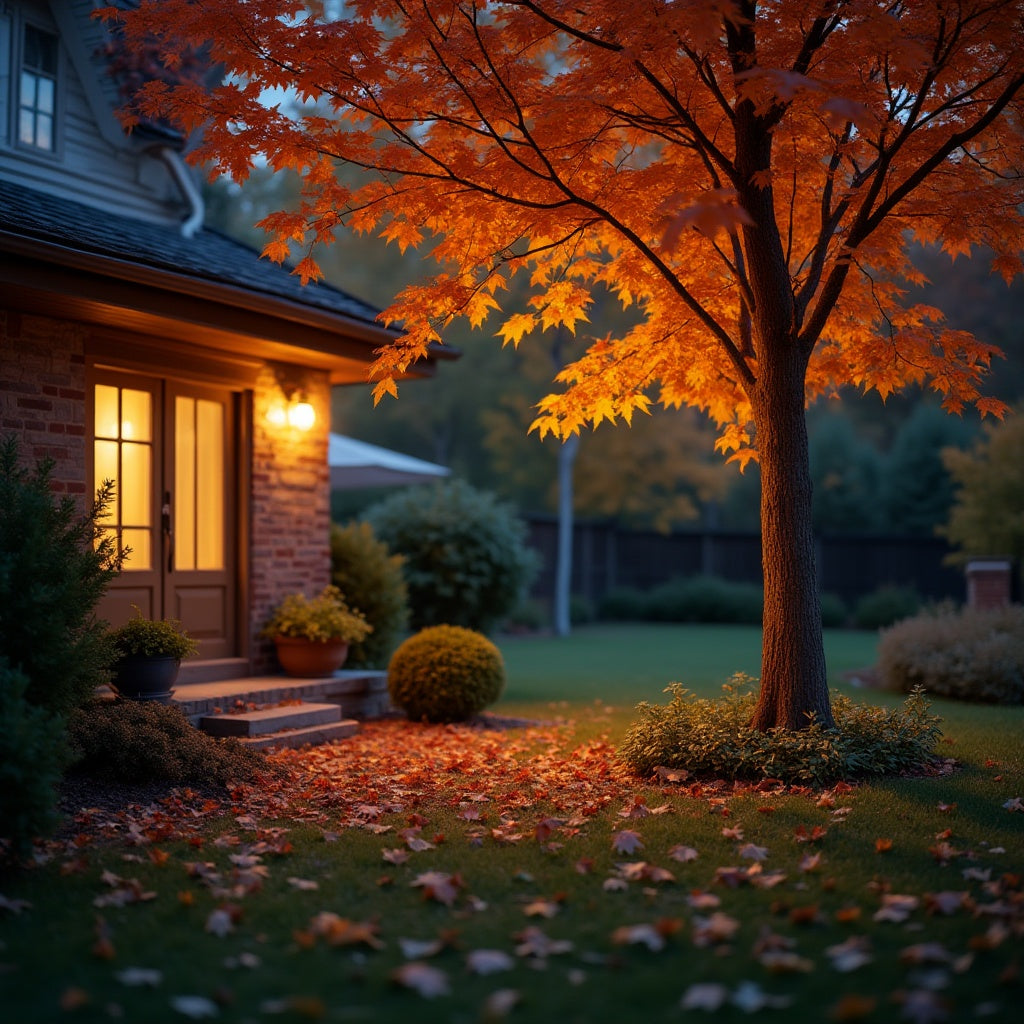
Brighten Up Your Fall Evenings: A Beginner's Guide to DIY Landscape Lighting
Share
As the crisp fall air begins to settle in and the daylight hours dwindle, it's the perfect time to consider adding a touch of warmth and charm to your outdoor spaces with DIY landscape lighting. This fun and fulfilling fall home project not only enhances the aesthetic appeal of your property but also improves curb appeal and makes your evenings more inviting. Whether you're a DIY enthusiast or a homeowner looking to explore energy-efficient lighting options, this guide will walk you through the essentials of installing outdoor lighting. From simple outdoor lighting ideas to step-by-step instructions, you'll find everything you need to illuminate your autumn nights with confidence and creativity.
Why Choose Fall for DIY Landscape Lighting
Perfect Time for Home Projects
Fall is an optimal season for tackling home projects, including DIY landscape lighting. The moderate temperatures make working outdoors more comfortable compared to the sweltering summer heat or the chilly winter frost. Additionally, the earlier sunsets provide ample opportunity to test and adjust your outdoor lighting in real-time, ensuring you achieve the desired effect. Autumn's natural beauty, with its vibrant foliage and crisp air, also complements the aesthetic enhancements that landscape lighting can bring. Engaging in fall home projects not only improves curb appeal but also prepares your outdoor space for holiday gatherings and cozy evenings. Whether you're a seasoned DIY enthusiast or a beginner, fall offers the perfect mix of conditions to embark on your DIY outdoor lighting journey with confidence and creativity.
Weather-Friendly Installation
Fall’s mild and predictable weather makes it an excellent time for installing landscape lighting. Unlike summer’s heat or winter’s cold, the temperate conditions of autumn allow for more comfortable and extended working hours outdoors. This makes tasks like digging trenches for wiring or positioning lights less strenuous. Moreover, the reduced likelihood of sudden rainstorms means fewer interruptions, allowing you to complete your project on schedule. The cooler temperatures also reduce the risk of overheating, both for you and any electrical equipment you might be using. By choosing to undertake your DIY outdoor lighting in the fall, you not only improve curb appeal but also ensure a smoother, more enjoyable installation process. This season's favorable conditions help you focus on creativity and precision, making your landscape lighting project a successful and satisfying endeavor.
Enhance Fall Evenings
Installing landscape lighting in the fall significantly enhances your outdoor evenings. As daylight hours shorten, well-placed lighting can extend the usability of your outdoor spaces, allowing you to enjoy crisp autumn nights on your patio or garden. The warm glow of energy-efficient lighting not only improves curb appeal but also creates a cozy, inviting atmosphere perfect for gatherings with family and friends. Whether it’s spotlighting the vibrant fall foliage, illuminating pathways, or highlighting architectural features, outdoor lighting ideas can transform your yard into a welcoming retreat. Additionally, thoughtful lighting can improve safety by reducing dark spots around your property, making it easier to navigate and deterring potential intruders. By enhancing your outdoor environment with DIY outdoor lighting, you create a beautiful, secure, and functional space that can be enjoyed throughout the fall season and beyond.
Getting Started with DIY Outdoor Lighting
Essential Tools and Materials
Before embarking on your DIY outdoor lighting project, it's crucial to gather the essential tools and materials. Start with the basics: a shovel or trenching tool for digging, a tape measure for accurate spacing, and a screwdriver for assembly. Depending on your project, you might also need wire strippers and a voltage tester to ensure safe electrical connections. For the lighting itself, consider energy-efficient options such as LED bulbs, which offer longevity and lower electricity costs. Additionally, you’ll need landscape lights specific to your design—options range from path lights to spotlights and well lights. Don't forget the necessary wiring and connectors to link your lights to a power source. If you’re aiming for convenience, Wi-Fi smart outlets can provide easy control over your lighting system. Having these tools and materials ready will streamline your installation process, ensuring a seamless and satisfying DIY experience.
Basic Safety Tips
Safety is paramount when working on your DIY outdoor lighting project. Start by turning off the power at the main circuit breaker to avoid any electrical hazards. Use a voltage tester to double-check that the power is off before you begin any wiring tasks. Always wear protective gear such as gloves and safety goggles to protect yourself from sharp objects and debris. When digging trenches for wiring, be mindful of existing underground utilities. Contact your local utility company to mark these lines before you start digging. Ensure that all electrical connections are waterproof to prevent short circuits and other electrical issues, especially in wet conditions. Use weather-resistant materials and fixtures specifically designed for outdoor use to withstand the elements. Lastly, follow the manufacturer’s instructions carefully for each component you install. By adhering to these basic safety tips, you can complete your project confidently and safely.
Choosing Energy-Efficient Lighting
Selecting energy-efficient lighting for your DIY outdoor project is both an eco-friendly and cost-effective choice. LED lights are a popular option due to their long lifespan and low energy consumption. They can last up to 25 times longer than traditional incandescent bulbs, saving you money on replacements and electricity bills. Solar-powered lights are another excellent choice, harnessing the sun's energy during the day and illuminating your yard at night without any additional cost. When choosing fixtures, look for those with an ENERGY STAR rating, which signifies that they meet strict energy efficiency guidelines. Additionally, consider using motion sensors or timers to ensure your lights are only on when needed, further reducing energy waste. By opting for energy-efficient lighting solutions, you not only improve curb appeal but also contribute to a more sustainable environment. This thoughtful approach allows you to enjoy beautifully lit outdoor spaces while being mindful of your energy use.
Outdoor Lighting Ideas to Improve Curb Appeal
Highlighting Walkways and Paths
Highlighting walkways and paths is an effective way to enhance curb appeal and ensure safety. Path lights create a welcoming ambiance while guiding visitors along outdoor routes. When installing path lights, space them evenly on either side of the path to provide balanced illumination. This not only highlights the path but also accentuates surrounding landscaping features. For a more dramatic effect, consider staggered lighting, which alternates lights from one side to the other, creating depth and interest. Bollard lights are another excellent choice, offering a modern look with their taller, column-like design. Use low-voltage fixtures to keep energy consumption low while ensuring sufficient light output. For DIY enthusiasts, solar-powered path lights offer an easy installation with no wiring required. By focusing on illuminating walkways and paths, you not only improve curb appeal but also enhance the safety and functionality of your outdoor space.
Accentuating Garden Features
Accentuating garden features with strategic lighting can transform your landscape into a nighttime showcase. Spotlights are ideal for highlighting specific elements like sculptures, fountains, or unique plantings. Position these lights at ground level, aiming them upwards to create dramatic shadows and emphasize textures. For larger features, consider using multiple spotlights from different angles to ensure even coverage and avoid harsh shadows. Well lights, recessed into the ground, are perfect for illuminating trees and larger shrubs from below, giving them a majestic appearance. If your garden includes water features, submersible pond lights can add a magical glow to the water, enhancing its visual appeal. When selecting fixtures, opt for energy-efficient options to maintain sustainability. By thoughtfully illuminating your garden features, you not only enhance curb appeal but also create a captivating outdoor environment that can be enjoyed both day and night.
Creating a Cozy Patio Ambiance
Creating a cozy patio ambiance with outdoor lighting can turn your seating area into a welcoming retreat. String lights, draped overhead or along railings, add a warm, festive glow that's perfect for evening gatherings. Lanterns and candles provide a soft, flickering light that enhances the intimate atmosphere. Consider incorporating solar-powered table lamps or portable LED lights for added convenience and energy efficiency. For a more permanent solution, wall-mounted sconces or overhead fixtures can offer consistent illumination while contributing to the overall design. Dimmer switches allow you to adjust the lighting intensity to match the mood, whether it's a lively party or a quiet evening. Accent lights can be used to highlight architectural details or garden features adjacent to the patio, seamlessly blending the indoor and outdoor spaces. By thoughtfully planning your patio lighting, you create an inviting space that enhances curb appeal and extends the usability of your outdoor area well into the night.
